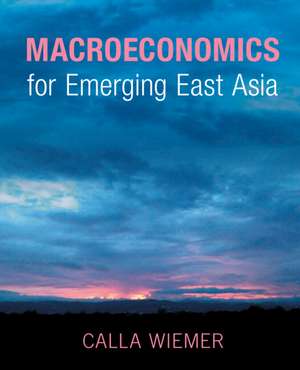Macroeconomics for Emerging East Asia
Autor Calla Wiemeren Limba Engleză Paperback – 30 noi 2022
| Toate formatele și edițiile | Preț | Express |
|---|---|---|
| Paperback (1) | 217.93 lei 6-8 săpt. | |
| Cambridge University Press – 30 noi 2022 | 217.93 lei 6-8 săpt. | |
| Hardback (1) | 542.61 lei 6-8 săpt. | |
| Cambridge University Press – 30 noi 2022 | 542.61 lei 6-8 săpt. |
Preț: 217.93 lei
Nou
Puncte Express: 327
Preț estimativ în valută:
41.70€ • 43.63$ • 34.64£
41.70€ • 43.63$ • 34.64£
Carte tipărită la comandă
Livrare economică 03-17 aprilie
Preluare comenzi: 021 569.72.76
Specificații
ISBN-13: 9781009152532
ISBN-10: 100915253X
Pagini: 400
Dimensiuni: 203 x 254 x 19 mm
Greutate: 0.7 kg
Editura: Cambridge University Press
Colecția Cambridge University Press
Locul publicării:Cambridge, United Kingdom
ISBN-10: 100915253X
Pagini: 400
Dimensiuni: 203 x 254 x 19 mm
Greutate: 0.7 kg
Editura: Cambridge University Press
Colecția Cambridge University Press
Locul publicării:Cambridge, United Kingdom
Cuprins
1. Fitting macroeconomics to emerging East Asia; 2. Taking the measure of emerging East Asia; 3. Microeconomic fundamentals; 4. National income and product accounts; 5. Balance of payments accounts; 6. Money; 7. Finance; 8. Exchange rates; 9. Models of equilibrium and disequilibrium; 10. Business cycles; 11. Monetary policy; 12. Fiscal policy; 13. Policy for internal and external balance; 14. Macroprudential policy; 15. Crises; 16. Epilogue.
Recenzii
'Calla Wiemer has written a highly readable, accessible, and analytically rigorous volume that will be of great value to scholars and policymakers both in East Asia and for anybody with an interest in this fascinating, diverse, and dynamic region. Macroeconomics for Emerging East Asia is grounded in mainstream macroeconomic theory and practice. But the author is rightly at pains to emphasize that the standard US macro textbooks are generally written with the implicit assumption that economies enjoy the 'exorbitant privilege' of possessing an internationally accepted reserve currency, and that this framework needs to be modified for the East Asian economies. An attractive feature of the volume is its application to real-world policy issues and challenges. These range from the misleading allegation, frequently directed at China and some other East Asian economies, of 'currency manipulation', to the origins and management of recent economic crises such as those of 1997–98, 2008–9, and the current pandemic. Highly recommended.' Hal Hill, H. W. Arndt Professor Emeritus of Southeast Asian Economies, Crawford School of Public Policy, Australian National University
'This excellent work clearly explains the interplay of macroeconomics, international finance, and development in an important – yet not completely familiar – part of the world. The author, an expert long familiar with the region, compellingly lays out the models necessary for analysis, while deploying data that highlights how emerging East Asia differs from other regions in macro behavior and response to policies. This is sure to become the reference for this subject.' Menzie Chinn, Professor of Public Affairs and Economics, University of Wisconsin–Madison
'In Macroeconomics for Emerging East Asia, Calla Wiemer skillfully presents theoretical concepts and policy topics in a highly lucid manner. The liberal use of examples from East Asia makes it attractive both to intermediate economics majors and to advanced students in public policy, business, and area studies.' Shinji Takagi, Distinguished Research Professor, Asian Growth Research Institute, and Professor Emeritus of Economics, Osaka University
'This excellent work clearly explains the interplay of macroeconomics, international finance, and development in an important – yet not completely familiar – part of the world. The author, an expert long familiar with the region, compellingly lays out the models necessary for analysis, while deploying data that highlights how emerging East Asia differs from other regions in macro behavior and response to policies. This is sure to become the reference for this subject.' Menzie Chinn, Professor of Public Affairs and Economics, University of Wisconsin–Madison
'In Macroeconomics for Emerging East Asia, Calla Wiemer skillfully presents theoretical concepts and policy topics in a highly lucid manner. The liberal use of examples from East Asia makes it attractive both to intermediate economics majors and to advanced students in public policy, business, and area studies.' Shinji Takagi, Distinguished Research Professor, Asian Growth Research Institute, and Professor Emeritus of Economics, Osaka University
Notă biografică
Descriere
Uses a distinctive approach to understanding macroeconomics for emerging East Asian economies using the latest data and case study analysis.
